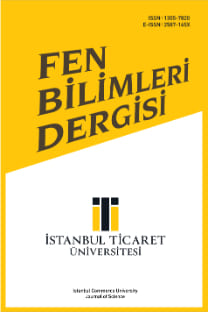İŞLETMELERİN İFLAS TAHMİNİNDE K- EN YAKIN KOMŞU ALGORİTMASI ÜZERİNDEN UZAKLIK ÖLÇÜTLERİNİN KARŞILAŞTIRILMASI
iflas tahmini, k-en yakın komşu, makine öğrenmesi, uzaklık ölçütleri
COMPARISON STUDY OF DISTANCE MEASURES USING K- NEAREST NEIGHBOR ALGORITHM ON BANKRUPTCY PREDICTION
___
- Alpaydin, E. (2010). Introduction to machine learning (2nd ed). MIT Press.
- Altman, E. I., & Hotchkiss, E. (2006). Corporate Financial Distress and Bankruptcy (Third Edition).
- Back, B. (1996). Choosing Bankruptcy Predictors Using Discriminant Analysis, Logit Analysis, and Genetic Algorithms. 20.
- Balcaen, S., & Ooghe, H. (2006). 35 years of studies on business failure: An overview of the classic statistical methodologies and their related problems. The British Accounting Review, 38(1), 63-93. https://doi.org/10.1016/j.bar.2005.09.001
- Bulut, F., & Osmani, S. (2017). Scene Change Detection using Different Color Pallets and Performance Comparison. Balkan Journal of Electrical and Computer Engineering, 66-72. https://doi.org/10.17694/bajece.336217
- Han, J., Kamber, M., & Pei, J. (2011). Data Mining Concepts and Techniques Third Edition (Third Edition). Morgan Kaufmann.
- Hastie, T., friedman, J., & Tibshirani, R. (2008). Unsupervised Learning. In: The Elements of Statistical Learning. https://doi.org/10.1007/978-0-387-84858-7_14
- Hu, L.-Y., Huang, M.-W., Ke, S.-W., & Tsai, C.-F. (2016). The distance function effect on k-nearest neighbor classification for medical datasets. SpringerPlus, 5(1), 1304. https://doi.org/10.1186/s40064-016-2941-7
- Khan, M., Ding, Q., & Perrizo, W. (2002). K-nearest Neighbor Classification on Spatial Data Streams Using P-trees. Advances in Knowledge Discovery and Data Mining, 2336, 517-528. https://doi.org/10.1007/3-540-47887-6_51
- Korol, T. (2019). Dynamic Bankruptcy Prediction Models for European Enterprises. Journal of Risk and Financial Management, 12(4), 185. https://doi.org/10.3390/jrfm12040185
- Kotsiantis, S. B. (2007). Supervised Machine Learning: A Review of Classification Techniques. 20.
- Liang, D., Lu, C.-C., Tsai, C.-F., & Shih, G.-A. (2016). Financial ratios and corporate governance indicators in bankruptcy prediction: A comprehensive study. European Journal of Operational Research, 252(2), 561-572. https://doi.org/10.1016/j.ejor.2016.01.012
- Mitchell, T. M. (2006). The Discipline of Machine Learning.
- Prasath, V. B. S., Alfeilat, H. A. A., Hassanat, A. B. A., Lasassmeh, O., Tarawneh, A. S., Alhasanat, M. B., & Salman, H. S. E. (2019). Distance and Similarity Measures Effect on the Performance of K-Nearest Neighbor Classifier—A Review. Big Data, 7(4), 221-248. https://doi.org/10.1089/big.2018.0175
- Thian Cheng Lim, Lim Xiu Yun, J., Siwei, G., & Jiang, H. (2012). Bankruptcy Prediction: Theoretical Framework Proposal. International Journal of Management Sciences and Business Research, 1(9), 69-74.
- UCI, https://archive.ics.uci.edu/ml/datasets/Taiwanese+Bankruptcy+Prediction, Erişim Tarihi: 25.08.2020
- Weber, M. (2000). Unsupervised Learning of Models for Object Recognition. 127.
- Weinberger, K. Q., Blitzer, J., & Saul, L. K. (t.y.). Distance Metric Learning for Large Margin Nearest Neighbor Classification. 8.
- ISSN: 1305-7820
- Yayın Aralığı: 2
- Başlangıç: 2002
- Yayıncı: Doç. Dr. Necip Şimşek
BAZI SINIR DEĞER PROBLEMLERİ İÇİN YENİ ÜRETİCİ ÇEKİRDEKLER VE HOMOJENLEŞTİRME DÖNÜŞÜMLERİ
OTOMOTİV YAN SANAYİ SEKTÖRÜNDE TEDARİKÇİ SEÇİMİNDE AHP, BULANIK AHP VE BULANIK TOPSIS YAKLAŞIMI
Gizem DİLKİ, Özlem DENİZ BAŞAR
ÇOK KRİTERLİ KARAR VERME TEKNİKLERİ İLE LOJİSTİK PERFORMANSIN DEĞERLENDİRİLMESİ
METRO ARACI GÖVDE SON MONTAJ TESİSİNİN KURULUMU VE YATIRIMIN FİNANSAL DEĞERLENDİRİLMESİ
Hüsnü Levent PANDÜL, Tuncer TOPRAK
İŞLETMELERDE VERİ ANALİZİYLE İSTİSNALARIN SAPTANMASI
Turgay KADIOĞLU, Tuncer TOPRAK
KVKK VE GDPR KAPSAMINDA FİRMALARIN MEVCUT DURUM ANALİZİ ÜZERİNE BİR İNCELEME
